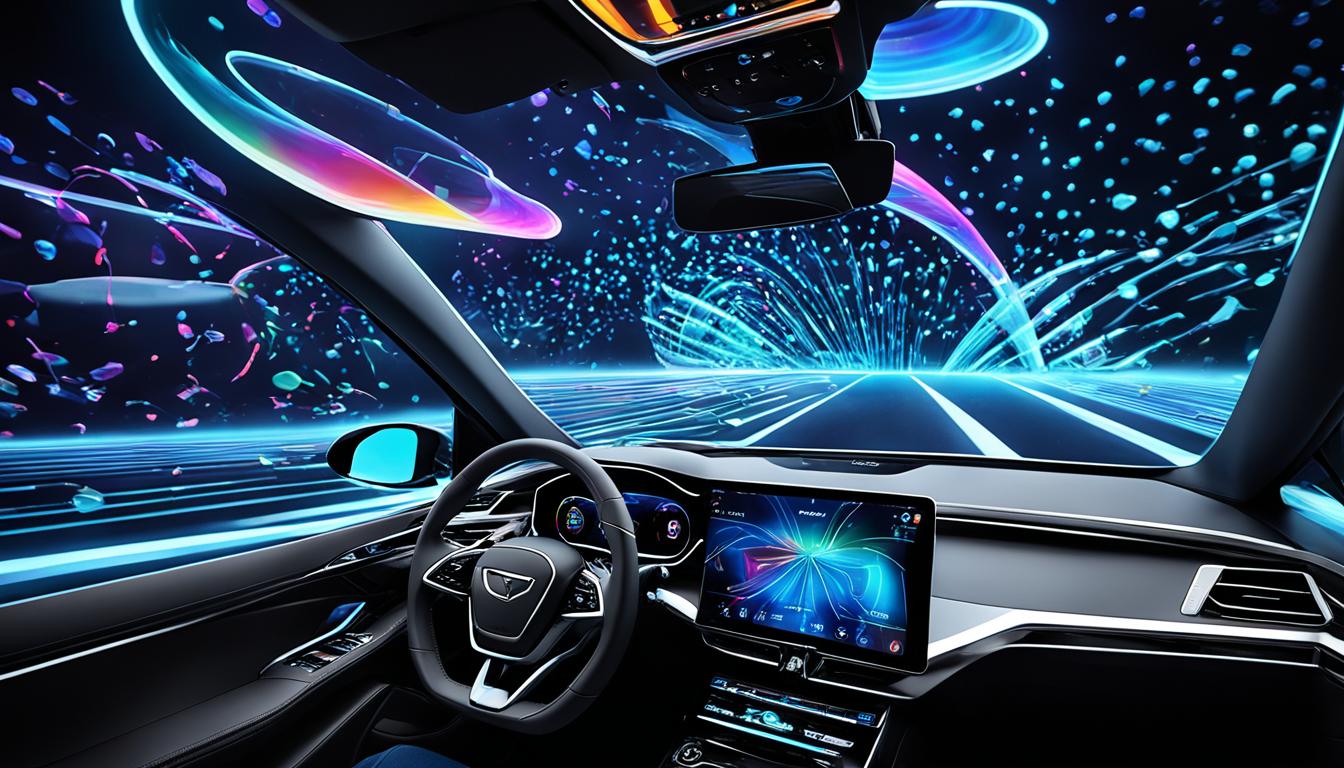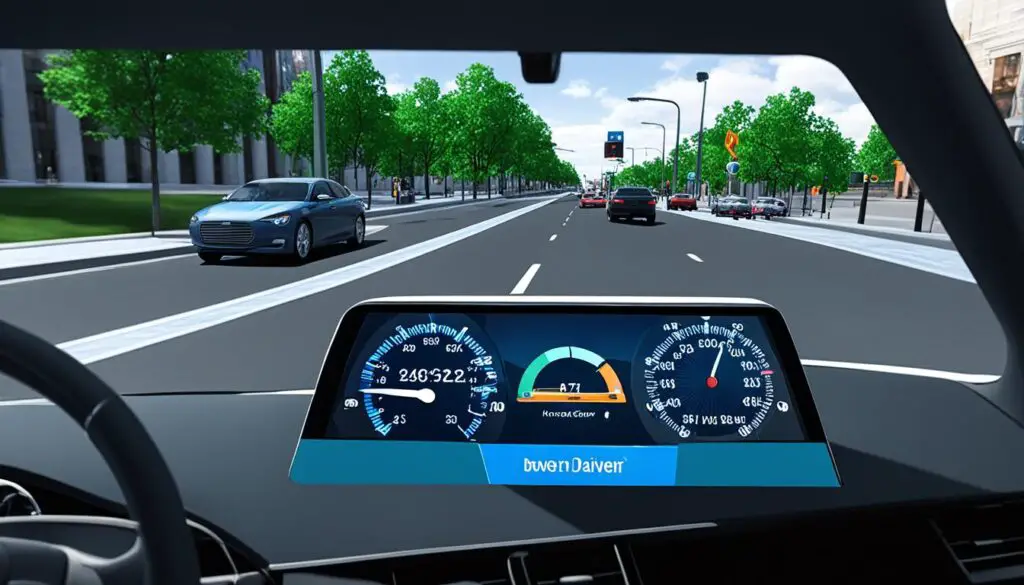
Augmented Reality Dashboards: A Glimpse into the Future of Driving
Augmented reality (AR) dashboards are revolutionizing the driving experience, providing drivers with cutting-edge visuals and real-time information. With AR technology, digital information is overlayed onto the real-world view through the windshield, creating an immersive and interactive driving experience.
AR dashboards offer a range of features, including navigation guidance, speed and traffic information, and safety alerts, enhancing driver awareness and reducing distractions. This technology is rapidly growing, with the market for wearable electronics, including AR dashboards, projected to reach $173.7 billion by 2030.
Key Takeaways:
- AR dashboards enhance the driving experience with advanced visuals and real-time information.
- These dashboards use AR technology to overlay digital information onto the real-world view through the windshield.
- AR dashboards offer features like navigation guidance, speed and traffic information, and safety alerts.
- The market for wearable electronics, including AR dashboards, is projected to reach $173.7 billion by 2030.
- The future of driving is here with augmented reality dashboards.
How AR Dashboards Work and Their Benefits
AR dashboards leverage augmented reality technology to enhance the driving experience by providing real-time information and improving safety and driver awareness. These innovative dashboards utilize sensors and cameras to capture data about the vehicle’s surroundings, which is then processed and overlaid with relevant digital information. This information, including navigation instructions, speed limits, and safety alerts, is projected onto the windshield or a heads-up display (HUD) in the driver’s field of view.
“AR dashboards enable drivers to have instant access to crucial information without diverting their eyes from the road. This enhances safety and minimizes distractions, allowing drivers to focus on the task at hand.”
By seamlessly integrating real-time information with the driver’s view of the road, AR dashboards provide numerous benefits. Firstly, they improve safety by ensuring that drivers have access to essential information without having to look away from the road. This real-time information includes navigation instructions, traffic alerts, and road condition updates, enabling drivers to make informed decisions quickly.
In addition to enhanced safety, AR dashboards also improve driver awareness. By overlaying digital information onto the real-world view, these dashboards enable drivers to gather information at a glance, minimizing the time and effort required to process information. This heightened awareness allows drivers to react swiftly to potential hazards, reducing the risk of accidents.
Moreover, AR dashboards offer personalized settings that can be customized to meet individual preferences, making the driving experience more enjoyable and convenient. Drivers can choose which information is displayed, ranging from speed and fuel economy to weather updates and incoming calls. This tailored experience enhances comfort and ensures that drivers have access to the information that matters most to them.
Benefits of AR Dashboards:
- Real-time information at a glance
- Enhanced safety and reduced distractions
- Improved driver awareness and reaction time
- Personalized settings for a tailored driving experience
How AR Dashboards Work:
The following table provides an overview of the key components and processes involved in AR dashboards:
| Component | Description |
|---|---|
| Sensors and Cameras | Capture real-time data about the vehicle’s surroundings, including road conditions, vehicle position, and objects in proximity. |
| Data Processing | Analyze the captured data, extracting relevant information and identifying potential hazards or points of interest. |
| Augmented Reality Technology | Overlay the processed data onto the driver’s view of the road, projecting it onto the windshield or a heads-up display (HUD). |
| Real-time Information | Display essential information, such as navigation instructions, speed limits, and safety alerts, in the driver’s field of view. |

AR dashboards represent a significant advancement in automotive technology, providing drivers with real-time information and enhancing safety and awareness on the road. As this technology continues to evolve, we can expect even more innovative features and functionalities that will shape the future of driving.
Current and Future Applications of AR Dashboards
AR dashboards have revolutionized the automotive industry with their diverse range of applications. Let’s explore some of the key ways AR dashboards are enhancing the driving experience.
Navigation Assistance
AR dashboards applications, navigation assistance
One of the primary applications of AR dashboards is navigation assistance. By leveraging augmented reality technology, AR dashboards overlay turn-by-turn directions and landmarks onto the driver’s real-world view. This enables drivers to easily follow directions and navigate unfamiliar routes with confidence. Gone are the days of constantly glancing at a separate GPS device or smartphone for guidance. With AR dashboards, important navigation information is seamlessly integrated into the driver’s field of view, providing a safer and more convenient driving experience.
Virtual Assistant Integration
AR dashboards applications, virtual assistant integration
Another exciting application of AR dashboards is virtual assistant integration. By integrating popular virtual assistants like Siri or Google Assistant, drivers can interact with their AR dashboard using voice commands. This hands-free communication allows drivers to access various services, such as making calls, sending messages, and controlling connected devices, without taking their hands off the wheel or diverting their attention from the road. The integration of virtual assistants with AR dashboards not only enhances convenience but also improves safety by minimizing distractions.

With the combination of AR technology and virtual assistant integration, drivers can enjoy a seamless and personalized driving experience like never before.
Personalized Settings
AR dashboards applications, personalized settings
AR dashboards also offer personalized settings to cater to the individual preferences of drivers. By leveraging advanced customization features, drivers can tailor their AR dashboard’s layout, color schemes, and information display according to their preferences. This ensures a personalized driving experience that is both intuitive and visually appealing.
AR Dashboards Applications
| Applications | Features |
|---|---|
| Navigation Assistance | Turn-by-turn directions Landmark overlay |
| Virtual Assistant Integration | Hands-free communication Access to services |
| Personalized Settings | Customizable layout Color schemes |
As AR dashboards become more sophisticated and widely adopted, we can anticipate a growing number of innovative applications in the future. From augmented reality-enhanced safety features to immersive infotainment experiences, the possibilities are endless.
With their navigation assistance, virtual assistant integration, and personalized settings, AR dashboards are fundamentally transforming the driving experience and paving the way for a future where our vehicles seamlessly blend the physical and digital worlds.
Conclusion
Augmented reality dashboards are revolutionizing the driving experience, paving the way for the future of automotive technology. By seamlessly integrating cutting-edge visuals and real-time information, these dashboards enhance safety, increase driver awareness, and offer personalized settings. With ongoing technological advancements, we can anticipate even more integrated and intelligent AR dashboards that provide immersive driving experiences.
The future of driving is here, and augmented reality dashboards are leading the way. As more drivers embrace this transformative technology, roads will become safer, more efficient, and more enjoyable for everyone. The ability to access real-time information, such as navigation guidance, speed limits, and safety alerts, directly within the driver’s field of view is a game-changer.
As we look ahead, it’s clear that augmented reality dashboards hold immense potential for the automotive industry. From virtual assistant integration to personalized settings, these dashboards offer endless possibilities for innovation. Embracing the power of augmented reality dashboards ensures a driving experience that is not only futuristic but also optimized for convenience, safety, and efficiency.
FAQ
What is an augmented reality (AR) dashboard?
An augmented reality dashboard uses AR technology to overlay digital information onto the real-world view through the windshield, providing drivers with advanced visuals and real-time information.
How do AR dashboards work?
AR dashboards work by using sensors and cameras to capture real-time data about the vehicle’s surroundings. This data is then processed and overlaid with relevant digital information, such as navigation instructions and safety alerts, allowing drivers to see the information as if it were in their field of view.
What are the benefits of AR dashboards?
AR dashboards enhance the driving experience by improving safety, increasing driver awareness, and offering personalized settings. They provide cutting-edge visuals and real-time information without diverting the driver’s eyes from the road.
What are the applications of AR dashboards?
AR dashboards have applications in navigation assistance, where they overlay turn-by-turn directions onto the real-world view, making it easier for drivers to follow directions. They also integrate with virtual assistants, allowing for hands-free communication and access to various services such as making calls and controlling connected devices in the vehicle.
How are AR dashboards changing the future of driving?
AR dashboards offer a glimpse into the future of automotive technology by providing cutting-edge visuals and real-time information. They enhance safety, increase driver awareness, and offer personalized settings. As technology advances, we can expect even more innovative features and functionalities from AR dashboards.
